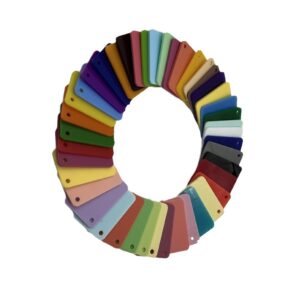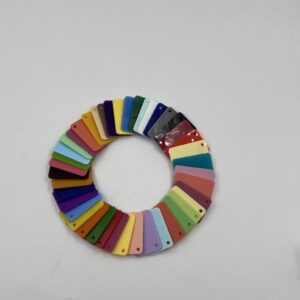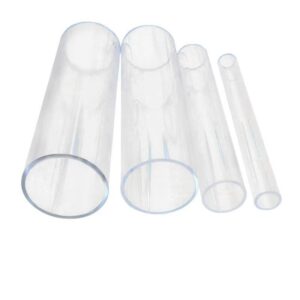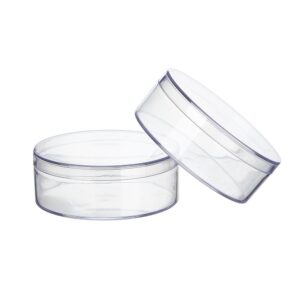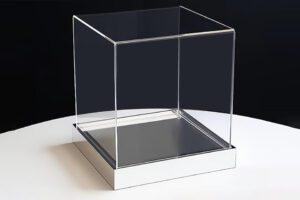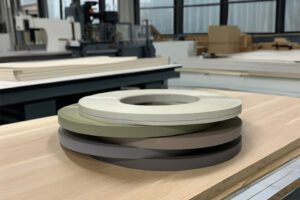Summary
Modern acrylic furniture trends in 2025 showcase a dynamic interplay of sustainability, innovative design, and nostalgic aesthetics. As a material known for its durability and versatility, acrylic is experiencing a renaissance in furniture design, appealing to consumers who prioritize eco-friendly options without sacrificing style. This resurgence is driven by a new generation of designers and brands who are pushing the boundaries of traditional forms, incorporating unique textures, colors, and sustainable practices into their offerings, making acrylic furniture a central element in contemporary home decor.
The current design landscape emphasizes a blend of classic and modern elements, with a noticeable shift towards softer, organic hues and traditional detailing. In 2025, the Color of the Year, “Quietude,” reflects a broader trend towards tranquility and natural connections in interior spaces. This preference for nostalgia manifests in a backlash against fast-paced trends, leading consumers to seek out pieces that offer a sense of history and craftsmanship. Additionally, the integration of acrylic with other materials such as wood and metal enhances its appeal, providing a rich aesthetic that meets modern consumer desires for versatility and personalization.
Sustainability is at the forefront of contemporary furniture design, with acrylic being recognized for its recyclability and energy-efficient production methods. Brands are increasingly focusing on eco-friendly practices, responding to the growing demand for sustainable products among consumers, many of whom express a willingness to modify their purchasing behavior in favor of environmentally responsible choices. This trend aligns with broader movements in biophilic design, where natural materials and aesthetics are prioritized to create harmonious living environments.
Prominent designers and brands are championing the modern acrylic furniture movement, showcasing innovative designs that blend form and function. Notable figures such as Philippe Starck and emerging brands like Stylenations exemplify the industry’s commitment to eco-conscious craftsmanship while introducing striking and unique pieces that cater to the evolving tastes of contemporary consumers. As the acrylic furniture market continues to expand, projected to grow at a compound annual growth rate of up to 5.85% through 2034, it is clear that this trend is not just a passing phase but a significant shift in how we approach furniture design in an increasingly sustainability-focused world.
Table of Contents
Historical Context
Acrylic furniture has a rich history that traces back to its origins in the 1930s. Initially, acrylic materials found their primary use in industrial and commercial settings, appreciated for their durability and versatility. However, the design landscape began to transform during the 1960s, when acrylic furniture surged in popularity, becoming a symbol of modern aesthetics and innovation. This period saw designers experimenting with new shapes and functionalities, leading to iconic pieces that remain influential today.
The evolution of acrylic furniture can also be viewed through the lens of broader design movements. The 1960s were characterized by a fascination with space-age themes and futuristic designs, which led to the creation of sleek, transparent furniture that embodied the era’s optimism and creativity. As a result, acrylic pieces were often celebrated for their minimalist yet bold expressions, seamlessly fitting into both residential and commercial interiors.
As design sensibilities shifted over the decades, acrylic furniture adapted accordingly. The 1980s and 1990s saw a wave of consumerism and materialism, which heavily influenced furniture design trends, often favoring more ostentatious and elaborate styles. In contrast, the current zeitgeist emphasizes sustainability and eco-friendliness, prompting designers to revisit acrylic as a material that can blend modern aesthetics with responsible design practices.
Today, acrylic furniture not only serves as a stylish and functional choice but also reflects a growing awareness of environmental concerns within the design community. Modern techniques in acrylic fabrication allow for the creation of intricate and innovative designs that honor both the material’s legacy and contemporary values, paving the way for a new era in furniture design that emphasizes sustainability, versatility, and cultural relevance.
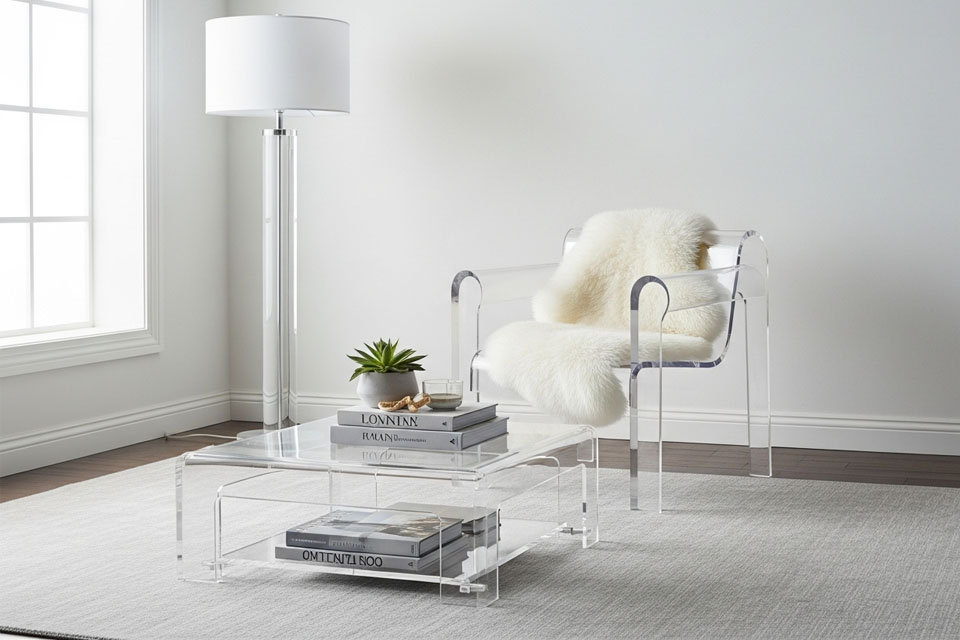
Current Trends in 2025
In 2025, the landscape of modern furniture design is characterized by a blend of traditional and innovative elements, with acrylic furniture playing a pivotal role in these trends. The year has seen a resurgence of classic styles, where designers are embracing traditional detailing and timeless aesthetics. This movement towards nostalgia reflects a broader anti-trend sentiment, prioritizing pieces that resonate with a sense of history and craftsmanship.
Material Innovations
Acrylic, known for its exceptional durability and versatility, is increasingly favored in contemporary furniture design. Its lightweight nature, combined with impact resistance and optical clarity, makes it an ideal alternative to traditional materials like glass. As designers experiment with different textures, the mixed materials trend is emerging, encouraging the combination of acrylic with wood, metal, or fabric for a rich, dimensional look. This trend not only enhances the visual appeal of spaces but also adds functional benefits, as acrylic furniture is easier to move and maintain compared to glass counterparts.
Color Trends
Color trends in 2025 are also evolving, with a focus on soft and organic hues. The 2025 Color of the Year, Quietude, alongside the Naturally Refined collection, embodies a palette that promotes tranquility and connection to nature. At industry events such as the High Point Market and the ICFF trade show, designers showcased rich, warm desert tones, including variations of pink, purple, and caramel, reminiscent of sunset colors. These colors are increasingly being incorporated into upholstered furniture, rugs, and wall coverings, creating a cohesive aesthetic that complements the modern use of acrylic materials.
Sustainable Practices
Sustainability continues to be a crucial consideration in furniture design. Acrylic is recognized not only for its durability but also for its environmental benefits, such as being recyclable and energy efficient to produce. As consumers prioritize eco-friendly options, the demand for sustainable materials is likely to influence the future of furniture design further, aligning with the broader biophilic design trends that are gaining traction in 2025.
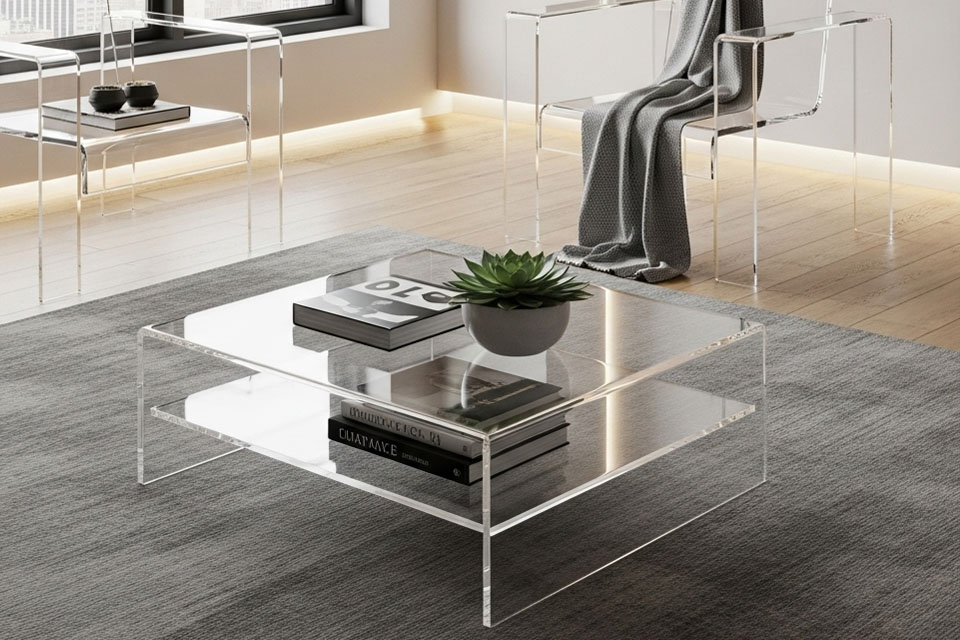
Key Designers and Brands
Innovative Designers
Acrylic furniture has seen a resurgence in popularity, driven by a new generation of designers who are pushing the boundaries of its aesthetic and functional possibilities. Notable figures like Philippe Starck have contributed significantly to the trend, with iconic pieces such as the Louis Ghost Chair that combines transparency with modern design sensibilities. Other designers are exploring playful organic shapes and minimalist lines, integrating acrylic with metallic accents to create striking compositions that appeal to contemporary tastes.
Emerging Brands
Several brands have emerged as frontrunners in the acrylic furniture market, each with a unique approach to design and sustainability. Stylenations, for example, stands out for its commitment to eco-friendly practices, utilizing responsibly sourced materials and recycled inputs in its manufacturing processes. This brand exemplifies how sustainability can be harmoniously integrated with stylish design.
Another key player is Professional Acrylic, known for its custom acrylic works that cater to both residential and commercial spaces in Dubai and beyond. Their innovative fabrication techniques allow for the creation of intricate furniture pieces that retain the benefits of acrylic, such as durability and versatility, while also meeting modern aesthetic demands.
Established Brands
In addition to emerging names, established brands are also reimagining their acrylic offerings. Many are incorporating elements of craftsmanship and personalized design, reflecting a broader trend toward bespoke interiors. For instance, larger retailers are collaborating with new designers to introduce handmade and unique acrylic pieces, thus providing customers with a connection to the artistry behind the furniture.
This evolving landscape of acrylic furniture design showcases a vibrant interplay of creativity, sustainability, and consumer demand for unique and functional home decor solutions.
Sustainability and Environmental Impact
Modern acrylic furniture trends in 2025 are increasingly focused on sustainability and reducing environmental impact. As awareness of climate change and ecological degradation rises, consumers are demanding that brands commit to responsible practices that align with the three pillars of sustainability: environment, society, and economy.
Environmental Sustainability in Acrylic Manufacturing
The acrylic industry is responding to these demands by developing eco-friendly and recyclable materials, significantly enhancing its sustainability profile. Companies are prioritizing the reduction of volatile organic compound (VOC) emissions and are innovating ways to incorporate recycled inputs into their manufacturing processes. In 2023, only 9.1% of global plastic was recycled, highlighting a substantial opportunity for industry players to increase their use of second-hand materials. Brands that utilize recycled materials not only report cost reductions of up to 30% but also improve their overall sustainability credentials, appealing to environmentally conscious consumers.
Acrylic itself has unique recycling potential. Polymethyl methacrylate (PMMA), commonly known as acrylic, can be recycled indefinitely, allowing manufacturers to create new products from 100% recycled content. The closed-loop recycling process minimizes waste by reprocessing acrylic scrap into new materials, which can then be used in various applications, including furniture. One innovative product, Recrylic, is made from recycled acrylic and is fully recyclable, presenting a viable solution to the sustainability challenge.
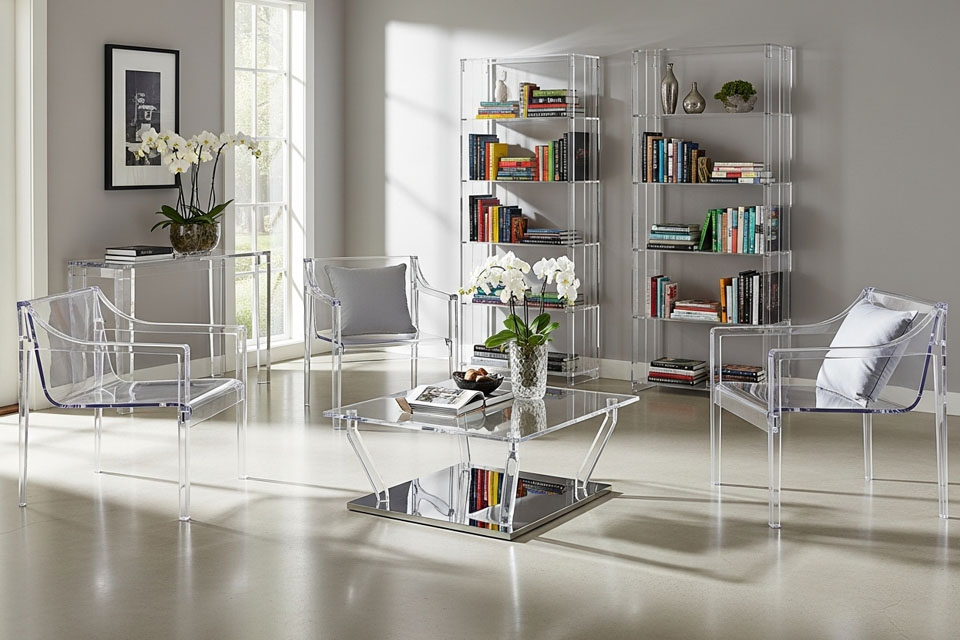
Energy Efficiency and Eco-Friendly Practices
In addition to using sustainable materials, the design and manufacturing processes are also evolving to incorporate energy-efficient practices. Research shows that products designed with energy efficiency can reduce customer energy costs by up to 30% annually. Furthermore, manufacturers are increasingly adopting modular designs that allow for easy upgrades and repairs, extending product lifecycles by as much as 50% and reducing landfill waste.
Sustainable practices in acrylic furniture production are not limited to materials and design. Companies are exploring ways to switch to renewable energy sources for manufacturing, integrate artificial intelligence to enhance efficiency, and transition to eco-friendly transportation methods. Iconic brands, like Herman Miller, have taken significant steps towards sustainability by committing to 100% renewable energy usage in their facilities since 2010.
Consumer Preferences and Market Trends
As the landscape of consumer behavior evolves, there is a marked shift toward sustainability and eco-conscious purchasing decisions, particularly in the realm of modern acrylic furniture. Research indicates that approximately 73% of consumers express a preference for sustainable products, with many willing to alter their shopping habits to reduce environmental impact. This inclination is further evidenced by the finding that 58% of shoppers are more likely to engage with brands that actively contribute to sustainability initiatives, such as carbon offset programs.
Sustainability in Product Design
The emphasis on eco-friendly materials is becoming increasingly critical in product design. A notable trend is the integration of biodegradable and recyclable materials, as consumers prioritize brands that adopt circular economy principles and provide options for reuse or recycling. This shift has led to a significant increase in sales for eco-friendly products, with reports indicating a 30% rise in recent years. Furthermore, companies that effectively communicate their sustainability efforts tend to cultivate stronger customer loyalty, with nearly 70% of customers seeking clearer information on product sustainability.
The Impact of Social Media and Community Engagement
Social media plays a crucial role in shaping consumer purchasing decisions, with 54% of users reporting they have purchased products discovered through these platforms. Brands that leverage interactive content and influencer partnerships can significantly enhance their visibility and appeal to eco-conscious consumers. Additionally, community involvement is vital, as 62% of consumers feel a stronger loyalty to brands that engage in socially responsible initiatives.
Market Trends in Acrylic Furniture
The acrylic furniture market is projected to grow at a compound annual growth rate (CAGR) of 4.74% to 5.85% through 2034, driven by its aesthetic appeal and versatility. Acrylic products, such as chairs and tables, have become increasingly popular due to their durability and lightweight nature, making them suitable for modern, minimalist interiors. There is also a rising demand for customizable designs that align with consumer preferences for personalization.
Moreover, advancements in acrylic fabrication techniques have enabled the creation of intricate furniture pieces that compete with traditional materials, further enhancing their market appeal. As companies like Sunday Knight Co. introduce sustainable acrylic product lines, the focus on environmentally responsible practices positions them as leaders in the evolving retail landscape.
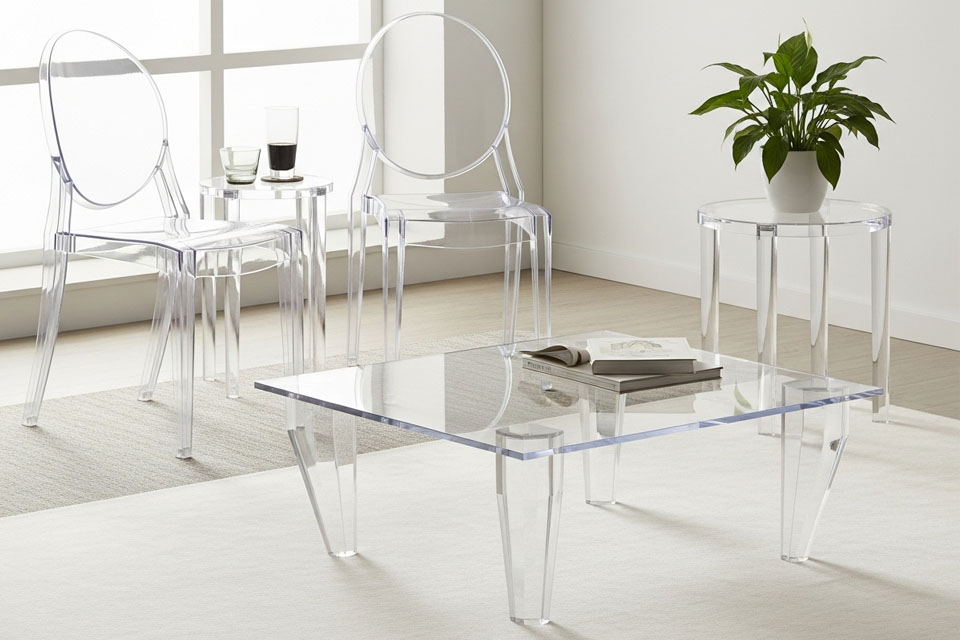
Consumer Preferences and Market Trends
As the landscape of consumer behavior evolves, there is a marked shift toward sustainability and eco-conscious purchasing decisions, particularly in the realm of modern acrylic furniture. Research indicates that approximately 73% of consumers express a preference for sustainable products, with many willing to alter their shopping habits to reduce environmental impact. This inclination is further evidenced by the finding that 58% of shoppers are more likely to engage with brands that actively contribute to sustainability initiatives, such as carbon offset programs.
Sustainability in Product Design
The emphasis on eco-friendly materials is becoming increasingly critical in product design. A notable trend is the integration of biodegradable and recyclable materials, as consumers prioritize brands that adopt circular economy principles and provide options for reuse or recycling. This shift has led to a significant increase in sales for eco-friendly products, with reports indicating a 30% rise in recent years. Furthermore, companies that effectively communicate their sustainability efforts tend to cultivate stronger customer loyalty, with nearly 70% of customers seeking clearer information on product sustainability.
The Impact of Social Media and Community Engagement
Social media plays a crucial role in shaping consumer purchasing decisions, with 54% of users reporting they have purchased products discovered through these platforms. Brands that leverage interactive content and influencer partnerships can significantly enhance their visibility and appeal to eco-conscious consumers. Additionally, community involvement is vital, as 62% of consumers feel a stronger loyalty to brands that engage in socially responsible initiatives.
Market Trends in Acrylic Furniture
The acrylic furniture market is projected to grow at a compound annual growth rate (CAGR) of 4.74% to 5.85% through 2034, driven by its aesthetic appeal and versatility. Acrylic products, such as chairs and tables, have become increasingly popular due to their durability and lightweight nature, making them suitable for modern, minimalist interiors. There is also a rising demand for customizable designs that align with consumer preferences for personalization.
Moreover, advancements in acrylic fabrication techniques have enabled the creation of intricate furniture pieces that compete with traditional materials, further enhancing their market appeal. As companies like Sunday Knight Co. introduce sustainable acrylic product lines, the focus on environmentally responsible practices positions them as leaders in the evolving retail landscape.





